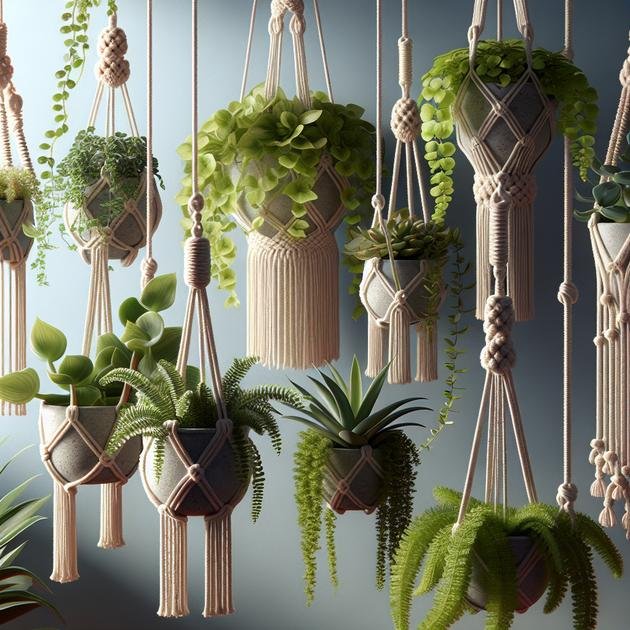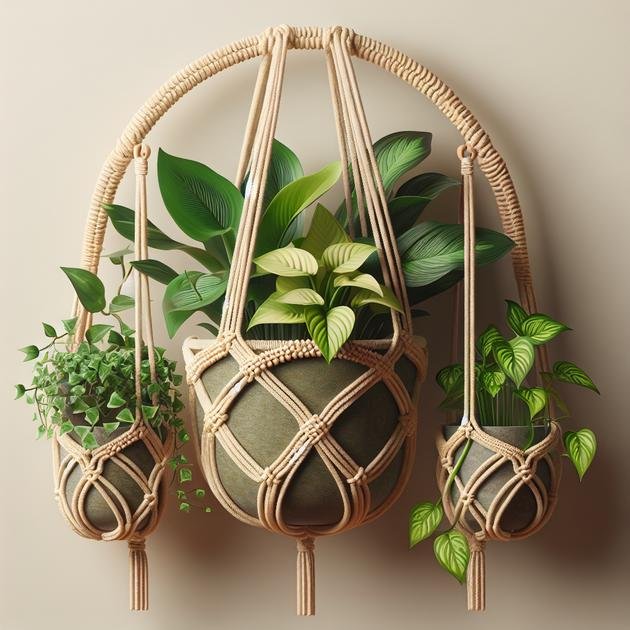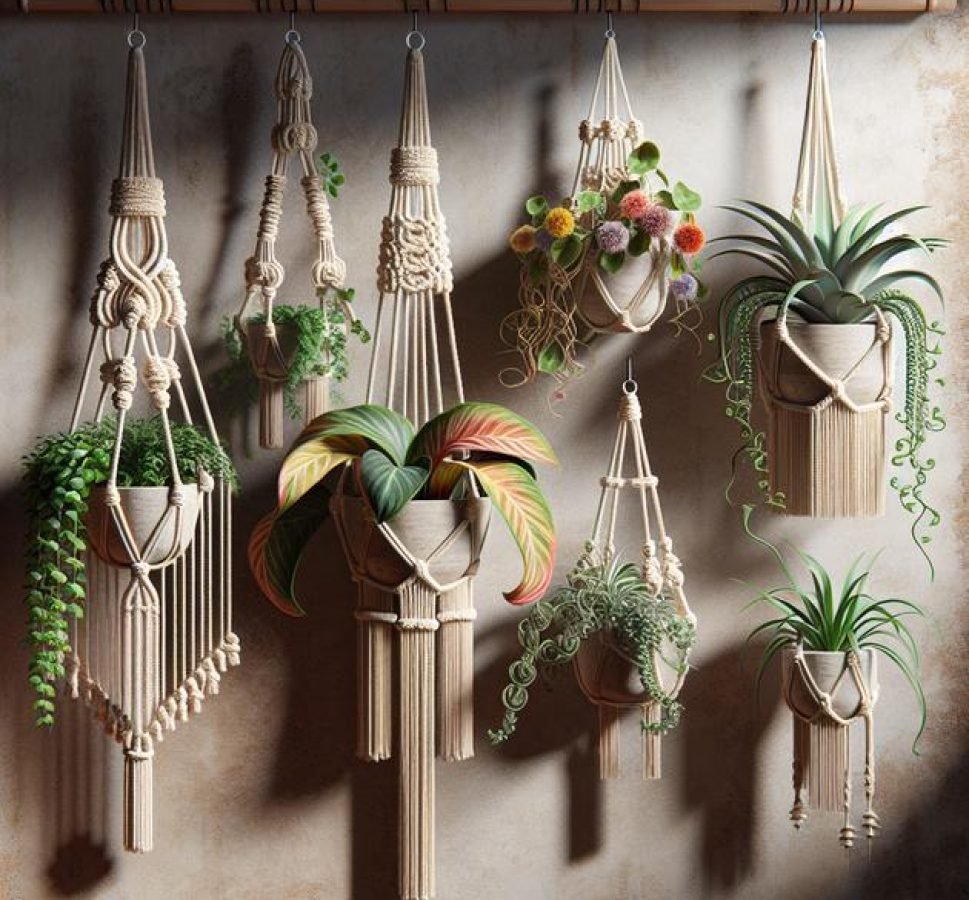DIY plant hangers are handcrafted holders for indoor plants made using macrame techniques, basic knots, and suitable materials, enabling personalized, stylish, and functional displays that enhance home decor.
If you have a thing for plants and a bit of crafty curiosity, diy plant hangers might be just the weekend project you need. Ever thought about how those charming macrame pieces elevate any room? Stick around to see how easy it is to make your own without fancy tools or skills.
Materials needed to start your first macrame hanger
Before you dive into making your own macrame plant hanger, gather the right materials to ensure a smooth crafting experience. You will need cotton cord or yarn, typically 3-5 mm thick – this serves as the main thread for your knots and determines the sturdiness of your hanger. A wooden or metal ring is essential as the base to start your knotting.
Other useful tools include a pair of scissors sharp enough to cut through the cord cleanly, and a measuring tape to ensure your cords are cut to the right length. Additionally, a hook or rod to hang your project while working can make the tying process easier and more comfortable.
Optionally, you might want to have some beads or decorative accents to personalize your hanger. Choosing all-natural fibers like cotton not only looks great but also holds knots well, which is crucial for supporting your plants safely.
Prepare your workspace with enough lighting and a flat surface to keep materials organized. Having everything ready before starting will help you focus on learning the macrame knots without interruptions.
Basic knots explained step-by-step
Mastering the basic knots is key to creating beautiful macrame plant hangers. The first essential knot is the Lark’s Head Knot, used to attach your cords to the wooden ring or rod. To make it, fold the cord in half, place the loop under the ring, and pull the ends through the loop, tightening it securely.
The Square Knot is another fundamental knot. It’s made using four cords: the two outer cords act as working strands and the two inner cords as filler. Cross the left working cord over the filler cords, then bring the right working cord over the left, under the filler cords, and through the loop created. Pull tight. Repeat this step in reverse to complete the square knot.
Another important knot is the Half Hitch Knot. This knot is created by wrapping a working cord around a filler cord in a loop, then pulling it through the loop to tighten. Multiple half hitch knots can be combined to create spiral or diagonal patterns.
Practice these knots with short pieces of cord until you feel confident. Each knot builds on the other, allowing you to form a sturdy and decorative hanger. Use smooth, even tension. Clear practice results in beautiful, even macrame work.
Choosing the right plants and pots for hangers

Choosing the right plants and pots is crucial to make your diy plant hangers both beautiful and functional. Start by selecting plants that thrive indoors and tolerate the hanging position well, such as pothos, spider plants, or succulents. These plants usually have smaller root systems and can adapt to different light conditions.
When it comes to pots, opt for lightweight materials like plastic, fiberglass, or thin ceramic. Heavy pots can strain your macrame hanger and cause damage over time. Make sure the pot has drainage holes to prevent water buildup, which can harm plants.
Measure the pot’s diameter to ensure your hanger will fit snugly but not too tight. A loose fit might cause the pot to slip, while too tight may restrict plant growth. Round or slightly tapered pots work best with most macrame designs.
Consider the aesthetic as well: natural tones and simple pot designs often complement the boho-chic style of macrame. Adding a splash of color with vibrant pots can create a striking contrast but keep it balanced with your room’s decor. Proper selection ensures your plant hanger looks great and supports healthy plant growth.
Creating different styles of macrame patterns
Exploring different macrame patterns allows you to customize your plant hangers and match your personal style. One popular style is the spiral knot, created by repeatedly tying half hitch knots in the same direction, resulting in a twisting effect perfect for adding texture.
The diamond pattern uses square knots arranged to form diamond shapes. Start by creating several square knots, then knot pairs of cords together diagonally. This pattern offers a classic, symmetrical look that works well for traditional macrame hangers.
For a more open and airy style, try the netted pattern, which uses alternating square knots spaced apart, forming a mesh-like structure that allows the plant to be cradled gently.
Combining patterns can create unique designs: for example, alternating rows of square knots and spiral knots can add both structure and flow. Experiment with spacing and tension to change how dense or loose your plant hanger looks.
Using different cord thicknesses or colors within a pattern can further enhance the style. Remember, practice gives you the confidence to try new patterns and create something truly unique for your home.
Step-by-step guide to finishing your plant hanger
Finishing your macrame plant hanger well ensures it looks polished and stays strong. Start by carefully trimming all the cords at the bottom to an even length. Use sharp scissors to get clean cuts and avoid fraying.
To prevent the ends from unraveling, you can apply a small amount of clear glue or wrap the ends with thin thread tightly. Another popular finishing touch is to add decorative knots or beads just above the trimmed ends, enhancing your hanger’s style.
Make sure to tighten the last knots securely so your plant won’t slip through. If you used a ring at the top, double-check it is firmly held by the knots. You can gently tug each cord to ensure stability.
After finishing, give your hanger a gentle shake to test its balance. If it swings unevenly, adjust the cords evenly. Finally, hang your plant hanger in the desired spot and place your chosen potted plant inside.
Proper finishing not only boosts the look but also the durability of your handcrafted plant hanger, making sure it holds your plants safely and beautifully in your home.
Tips to hang and care for your new plant display

To hang your new macrame plant hanger safely, choose a sturdy ceiling hook or wall bracket that can support the combined weight of the hanger, pot, and plant. Use a stud finder to ensure you anchor the hook into a solid spot. Installing with proper hardware prevents accidents and protects your walls.
Consider placing your plant hanger near a window to provide adequate natural light for your plant’s needs. Rotate the hanger occasionally to promote even growth and prevent your plant from leaning to one side.
Remember to water your plants according to their type, and empty any excess water from the pot to avoid root rot. Check your hanger occasionally for signs of wear or loosening knots, and tighten or repair as needed.
Caring for your macrame hanger itself includes gently dusting the cords occasionally and avoiding exposure to direct moisture or sunlight that can weaken the fibers.
Regular maintenance ensures your plant display stays beautiful and secure, letting you enjoy vibrant greenery safely suspended in your home for a long time.
Troubleshooting common mistakes beginners face
Beginners often face some common mistakes when making macrame plant hangers, but with a little care, these can be easily fixed. One common issue is uneven knots, which can make your hanger look messy. To avoid this, maintain consistent tension while tying knots and practice regularly.
Another mistake is cutting cords too short. Always measure and leave extra length to ensure you have enough material to complete your design. If cords are too short, it can be difficult to finish the hanger properly.
Using the wrong thickness cord can also cause problems. Thicker cords might be hard to knot tightly, while very thin cords may not support the weight of pots and plants safely.
Improper hanging can lead to instability or even damage. Always use the correct hardware and ensure the hanger is securely fixed. Check your knots before hanging a heavy plant.
Lastly, beginners sometimes neglect plant and pot compatibility, leading to pots slipping or plants not thriving. Choose appropriate pots with drainage and plants suited for hanging.
Recognizing these mistakes early will save time and help you create strong, attractive macrame hangers.
Creative ideas to customize your plant hangers
Adding creative touches to your macrame plant hangers makes them truly unique and personal. One way to customize is by incorporating colored cords or dyed yarns into your design. Using different shades can create gradient effects or bold color contrasts that enhance your space’s vibe.
You can also add decorative beads, wooden rings, or feathers woven into the knots for extra texture and style. These elements transform simple hangers into eye-catching pieces.
Experiment with different cord thicknesses or materials. Mixing soft cotton with natural jute or hemp adds a rustic touch and interesting tactile variety.
Try varying knot patterns within one hanger to form stripes, waves, or geometric shapes. Layering multiple hangers with different lengths and styles in one area also creates a stunning, boho-inspired display.
Finally, personalize your hanger by attaching small charms or using fabric dye to add subtle patterns. These details express your personality and make your plant hanger a work of art.
Wrapping Up Your DIY Macrame Plant Hanger Journey
Creating your own diy plant hangers is a fun and rewarding way to add charm to your home. With the right materials and basic knots, anyone can craft a beautiful and sturdy hanger.
Choosing the right plants, pots, and patterns lets you tailor your hanger to fit your style and space perfectly. Paying attention to details like finishing touches and proper care helps your plant display stay safe and vibrant.
Don’t be afraid to get creative by adding colors, beads, or mixing patterns to make your hanger truly unique. With practice, you’ll develop confidence to try new designs and showcase your green thumb beautifully.
Enjoy the process and the natural beauty your handmade macrame plant hanger brings to your living space.





